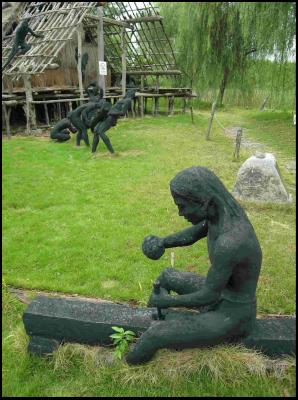NZ Study Confirms Ancient China/Aotearoa Links
NZ Study Tour Of Ancient China Confirms Links To Aotearoa

Click for big version
A team from the Watershed Systems Research Station Aotearoa (Twizel) returned recently from a study tour of the cultural heartlands of ancient China where they explored the origins of jade carving, Dao culture, science and technology and their relationships to the origins of Polynesian civilisation.
"Significant information relating to the origins of Polynesian people and Dao culture long thought to be lost in antiquity was re-discovered from ancient jade teaching stones" said team leader Prof Haikai Tane Director Watershed Systems. "The realisation that similar jade icons and Dao pictographs are also found in Aotearoa-NZ raises some very interesting questions about much older links between Aotearoa and ancient China" he said.
"Around 8000 years ago raft dwelling nomads from the East China Sea settled the river estuaries of Hangzhou Bay. By 7000 years ago a prototype Polynesian civilisation was well established at the Hemudu site in Zhejiang Province. Archaeologists uncovered the Hemudu site in the 1970's. Subsequent research has revealed a prototype Polynesian culture more advanced in some ways than their modern descendants.,The Hemudu are famous as the first jade carvers in China and the earliest rice farmers of southern China" said Prof Tane who has visited the Hemudu site three times.
"Clues to ancient connections with Aotearoa were found in Neolithic jade sites. Previously researchers were unable to find a practical function for abundant jade pieces called long-feng, cong and bi-discs. They are found throughout Neolithic China and were previously classified as personal ornaments, funerary pieces and primitive deities. The original meanings of symbols found on jade carvings and pictographs were revealed with the help of Dao scholars in China on previous trips. The recent study tour revealed the original functions of jade teaching stones, congs and bi-discs. This is leading to new understandings of Neolithic cultures that settled the Pacific" said author Barry Brailsford, a member of the study team.
During the Neolithic Age in China 10,000-3,500 BP (Before the Present), advanced Dao farming cultures developed sophisticated settlements and trading civilizations with the help of jade stoneware, analogue mapping and surveying systems, and axle technologies for wooden barrows, carts and other machines. With new knowledge of Dao symbolic logic, the team recorded three re-discoveries with far reaching implications for Pacific geography, the origins of Polynesian culture and settlement of the Pacific:
carved jade teaching stones were traditionally used for transmitting Dao cultural intelligence for sustainable development of watersheds, natural farming and village settlements as early as 7,000 BP. Carved jade axle bearing assemblies were developed for carts, barrows, waterwheels and other machines utilising wooden axles (5000-3000 BP) before being replaced by metal equivalents which occurrred much later. Analogue mapping and modelling systems were developed for integrated watershed management, enabled Dao systems of natural farming focusing on water not soil to be more productive than modern agriculture (5,000 ±BP). The team was invited to China by Professor Dai Xingzhao Chief International Cooperation, Jiangxi Department of Science and Technology, Nanchang. The study team comprised researchers, writers and recorders, a video cameraman and documentary film maker. The study team was checking and recording findings from research work into the origins of Dao culture conducted over the past five years by Prof Tane with colleagues from the Chinese Academy of Sciences in Shanxi, Shaanxi and Jiangxi Provinces.
Prof Haikai Tane presented papers on Dao pictographs and jade iconography in 2005 and 2006 to colleagues in the Chinese Academy of Sciences and at Jiaotong University Xi'an. In these papers he reported that modern Dao scholars in south and north China instantly recognised and easily interpreted pictographs originating from New Zealand's South Island, without having prior opportunity to study them or learn of their origins. The Dao scholars said the pictographs were Dao analogue maps of mountain river lake watersheds depicted in a style common in ancient China 4500 years ago. The South Island pictographs were found to be Dao analogue maps of the Mt Aoraki-Lake Pukaki watershed and the Mt Aspiring Lake Wanaka-Hawea watershed. Additional papers detailing these re-discoveries are planned for publication in 2008.
Watershed Systems is an independently funded training, research and development organisation operating in the Asia-Pacific region in accordance with international law for sustainable development and environmental protection. It operates collaboratively with partners in Australia and China.
ENDS


 Health Coalition Aotearoa: New Bill A Vital Step Towards Tobacco-Free Future In Aotearoa
Health Coalition Aotearoa: New Bill A Vital Step Towards Tobacco-Free Future In Aotearoa National Youth Theatre: 140 Christchurch Kids Shine In National Youth Theatre’s Historic CATS Premiere
National Youth Theatre: 140 Christchurch Kids Shine In National Youth Theatre’s Historic CATS Premiere NZ Symphony Orchestra: NZSO To Tour Masterworks By Mozart, Beethoven, Haydn And More
NZ Symphony Orchestra: NZSO To Tour Masterworks By Mozart, Beethoven, Haydn And More Journal Of Public Health: Vape Shops Cluster Around Schools
Journal Of Public Health: Vape Shops Cluster Around Schools Timaru District Council: Aigantighe Art Gallery Hosts An Iconic Robin White Touring Exhibition
Timaru District Council: Aigantighe Art Gallery Hosts An Iconic Robin White Touring Exhibition Victoria University of Wellington: Dame Winnie Laban Awarded Honorary Doctorate Recognising Achievements For Pasifika
Victoria University of Wellington: Dame Winnie Laban Awarded Honorary Doctorate Recognising Achievements For Pasifika 